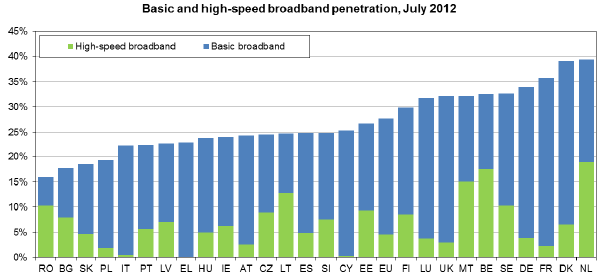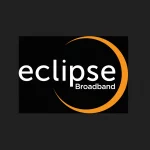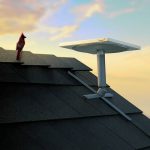EU Release Updated Broadband Access Coverage Report to July 2012
The European Commission (EC) has today published new data on the number of broadband lines and ISP speed in Member States, including the UK, gathered to July 2012. Overall 95.7% of EU homes are already passed by at least one fixed broadband ISP but 9.1 million homes still do not have coverage (over 90% of which are in rural areas).
The Point Topic compiled data shows that Europe is close to achieving its Digital Agenda target for 100% coverage of at least basic broadband services (0.5Mbps+) by the end of 2013. The situation for “high-speed” / “super-fast” Next Generation Access (NGA) broadband, which aims to offer speeds of at least 30Mbps to 100% of EU homes by 2020, remains a different story.
Advertisement
The report states that NGA services are now available to half of EU homes and 35 million out of the 40 million rural homes are still waiting for NGA to arrive. Meanwhile just 2.5% of lines (about 2% of homes) feature speeds of 100Mbps+ or above (the EU wants 50% of homes to be within reach of this by 2020) and only 12.1% were delivering headline-speeds of at least 30Mbps (about 8% of homes).

However more than half of all EU fixed broadband lines provide speeds equal to or higher than 10Mbps and unsurprisingly DSL (includes ADSL, FTTC / VDSL2 etc.) based solutions remain the dominant form of connectivity with a market share of 74.6% and falling (down by 6.2% since January 2006). Cable providers (e.g. Virgin Media) are the second most common fixed broadband technology with a stable market share of 17%.
It’s interesting to note that the total amount of broadband state aid approved in 2012 was approximately €6.5bn, which is more than three times higher than a year earlier. We can’t help but wonder whether this trend will now go in reverse given that around €8bn in future broadband funding through the Connecting Europe Facility (CEF) has just been wiped out due to budget cuts (here).
As of July 2012 total EU broadband penetration has reached 28.2% (up from 27% a year earlier). Elsewhere the UK pulls its weight in most areas but our performance for NGA services still suffers due to low uptake, although this improving.
Advertisement
Broadband Lines in the EU (July 2012 Statistics) – PDF
http://ec.europa.eu/…/document.cfm?doc_id=1700
Mark is a professional technology writer, IT consultant and computer engineer from Dorset (England), he also founded ISPreview in 1999 and enjoys analysing the latest telecoms and broadband developments. Find me on X (Twitter), Mastodon, Facebook, BlueSky, Threads.net and Linkedin.
« UK Analyst Criticises Super Expensive FTTH Broadband ISP Solutions


















































Comments are closed